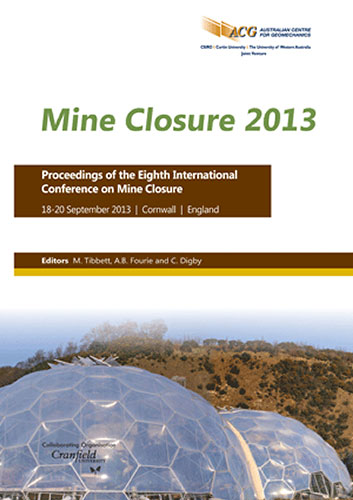Monitoring post-closure large scale surface deformation in mining areas

|
Authors: Banton, C; Bateson, L; McCormack, H; Holley, R; Watson, IA; Burren, R; Lawrence, D; Cigna, F Paper is not available for download Contact Us |
DOI https://doi.org/10.36487/ACG_rep/1352_09_Banton
Cite As:
Banton, C, Bateson, L, McCormack, H, Holley, R, Watson, IA, Burren, R, Lawrence, D & Cigna, F 2013, 'Monitoring post-closure large scale surface deformation in mining areas', in M Tibbett, AB Fourie & C Digby (eds), Mine Closure 2013: Proceedings of the Eighth International Seminar on Mine Closure, Australian Centre for Geomechanics, Cornwall, pp. 97-108, https://doi.org/10.36487/ACG_rep/1352_09_Banton
Abstract:
As a result of collaboration between the Coal Authority, NPA Satellite Mapping and the British Geological Survey, measurements of surface deformation have been analysed across a number of current and former UK mining areas. The work included a wide-area ground stability dataset produced using interferometric synthetic aperture radar (InSAR), with associated geological interpretation, to help the Coal Authority manage these areas. Results show an unexpected amount of surface deformation across wide areas of the country associated with former mining areas. In particular, many areas are experiencing wide-scale uplift at rates of millimetres per year, an impact that has not been well studied. This uplift is strongly correlated with rising groundwater due to the cessation of pumping following mine closure, and it extends across a wider area than affected by the previous surface deformation observed during active mining. It appears that defined ‘mining blocks’, often delineated by faults, and the order in which groundwater is thought to flood each block, have a control on the temporal and spatial pattern of surface uplift. InSAR has proved to be the most cost-effective way to map the wide-area surface deformation observed in these areas, with spatial coverage and measurement density exceeding those possible with conventional ground survey techniques. With remote, worldwide coverage, InSAR is also applicable in most environments. Forthcoming InSAR data sources will improve consistency and frequency of data acquisition, which will further expand capabilities and improve overall results. In key areas (e.g., critical infrastructure) future InSAR monitoring could be optimised, for example, by placement of artificial reflectors to increase measurement density. There is also potential for integration of data from boreholes, GPS and other ground−based survey methods to give a holistic multi-scale picture of groundwater and resulting ground deformation. The correlation between surface deformation and rising groundwater has allowed The Coal Authority to optimise its management of groundwater in a cost-effective manner across wide areas. The dataset provides a context within which a strategy for mitigating the effects of rising groundwater water can be developed. This provides cost and resource savings, for example by optimising placement of boreholes, and informs decisions on requirements for monitoring and/or modelling of groundwater post-closure. Investigation of the relationship between the observed ground deformation, groundwater level rise and the local geology also raises the possibility of prediction for future mine closures, feeding into informed decisions on the cessation of pumping and ongoing groundwater management.
References:
Donnelly, L.J. (2006) A review of coal mining-induced fault reactivation in Great Britain, Quarterly Journal of Engineering Geology & Hydrology, Vol. 39, pp. 5–50.
Mills, D.A.C. and Holliday, D.W. (1998) Geology of the district around Newcastle upon Tyne, Gateshead and Consett, Memoir of the British Geological Survey.
Werner, C., Wegmüller, U., Strozzi, T. and Wiesmann, A. (2003) Interferometric point target analysis for deformation mapping, in Proceedings of IGARSS, 21–25 July 2003, Toulouse, France, pp. 4362–4364.
© Copyright 2026, Australian Centre for Geomechanics (ACG), The University of Western Australia. All rights reserved.
View copyright/legal information
Please direct any queries or error reports to repository-acg@uwa.edu.au
View copyright/legal information
Please direct any queries or error reports to repository-acg@uwa.edu.au